|
Handling Excavated Material at Jerome Park Reservoir
Scientific American—July 6, 1901
This article and accompanying 6 photographs comes from a time before The Bronx,
NY was made a County.
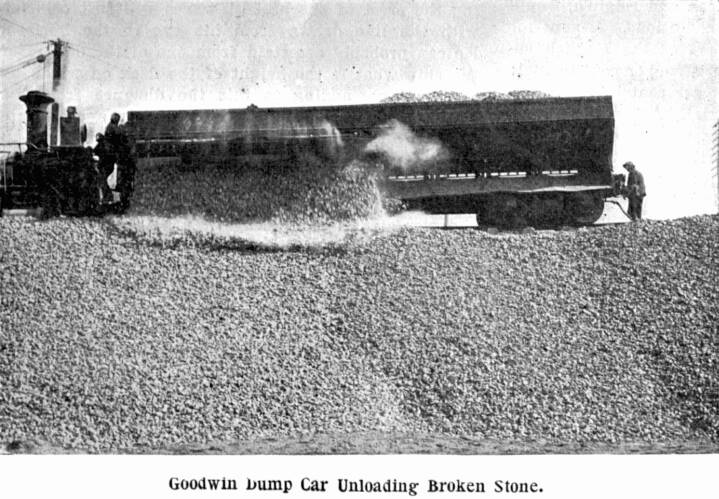
In a recent article describing the important work now being
done in creating a reservoir on the site of the old Jerome race
course, it was shown that the site of the reservoir is a natural
depression in a high ridge of land which runs in a general north
and south direction between the valleys in which are located the
New York and Putnam and the Harlem Railroads. Although the site
is naturally adapted for the excavation of an artificial basin,
there is, nevertheless, a huge amount of material to be taken
out before the reservoir will reach its designed capacity of 1,850,000,000
gallons. The completed reservoir will have a length in a north
and south direction of a little over a mile, and a greatest width
of half a mile, its area being 229 acres. As the whole of the
bottom is being excavated to a uniform depth of 26½ feet,
and the natural basin itself is filled with some stretches of
high ground which rise considerably above the described high-water
level of the reservoir, it can be understood that the total amount
of material to be taken out reaches a very high figure; in fact,
the estimated excavation at the present writing is a little under
7,000,000 cubic yards. The excavated material, however, occupies
considerably more space than it did in the solid mass, the increase
in the case of excavated rock being from 80 to 100 per cent. Hence
it follows that the contractors, at the time the excavation is
completed will have handled about 10,000,000 cubic yards of material,
measured at the dump.
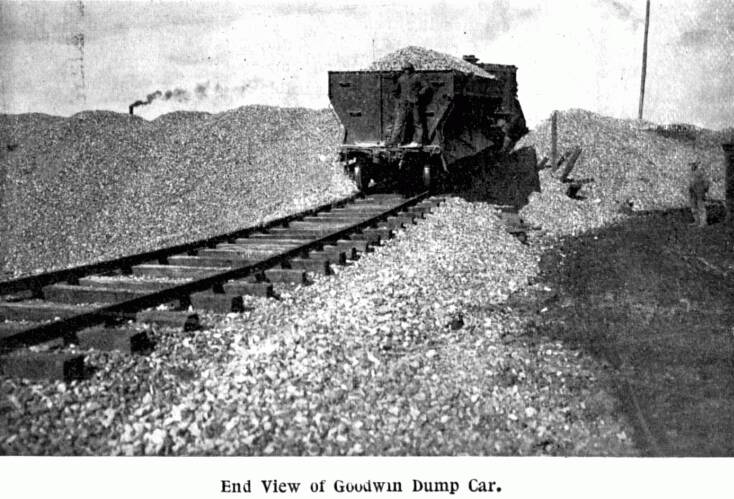
It is evident, then, that the question of getting out the rock,
sand and earth, is only part of the problem, for this huge quantity
has to be carried away and deposited on suitable dumping-grounds.
Fortunately, there are within the boundaries of New York city,
and within convenient distance of the reservoir, certain low-lying,
swampy lands which must be filled in or reclaimed, if they are
to be rendered serviceable; and for this work of refilling the
Jerome Park material offers an abundant supply. Of 4,000,000 cubic
yards which have been taken out to date, about 20 per cent has
been used in filling near the Kingsbridge road and in Bronx Park.
For the disposal of the other 80 per cent a single line of track
has been laid for a distance of 4 miles, through Bedford Park,
across the Harlem Railroad tracks, through Bronx Park and down
Pelham Bay Parkway to the stretch of tide lands formed by the
head waters of Westchester Creek and Westchester Bay, which is
known as the Meadows. Commencing where the Parkway leaves the
edge of the sloping grounds, this enormous mass of 3,200,000 cubic
yards of sand, gravel. hardpan and solid rock has been dumped
out upon the tide lands, until now a large proportion of a square
mile has been filled in to a depth of 18 to 20 feet.
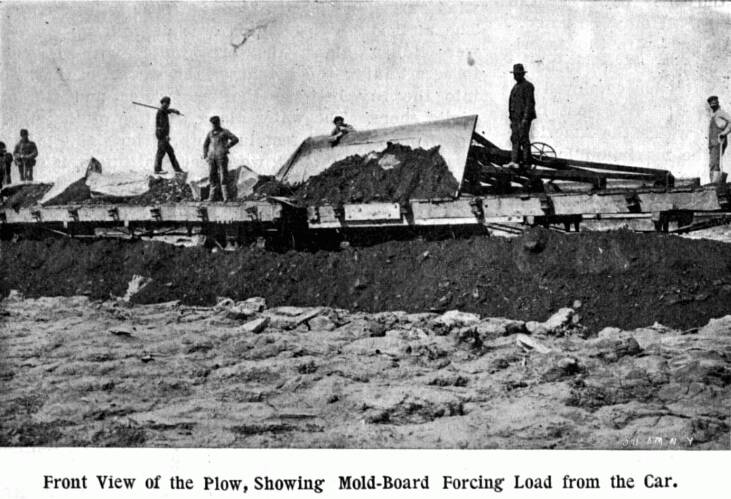
The illustrations which accompany this article show the modern
methods of handling and transporting this material, without which
the cost of carrying it away for a distance of 4 miles and dumping
it would be vastly increased. At the reservoir the cars are run
in trains of from ten to fifteen cars alongside the bluff which
is being excavated, and the material is loaded by derricks, if
it be rock, or by steam diggers if it be soft or loose material,
directly on to the flat-cars. The train-load is then run down
to the Meadows, where the engine is uncoupled and a train of empties
coupled on, to be taken back to the reservoir. The train-load
of material is now unloaded by means of a huge scraper-plow
which is known as the Barnhardt Side Plow. The unloading locomotive
engine, of which there are several employed at the dump, has coupled
in front of it a strongly-built flat-car, upon which is bolted
a Lidgerwood hoisting-engine of 180 horse power. The locomotive.
with its hoisting-engine car is backed down and coupled to the
front end of the train-load of material, while at the rear of
the train is coupled up the car on which is mounted the massive
side plow. The latter is so clearly shown in our illustration
that it needs no detailed description. The face of the mold-board
is a heavy plate of steel, which extends diagonally across the
car, the rear edge of the mold-board projecting slightly beyond
the side of the car platform. The line side of the plow consists
of a heavy stick of timber which is shod with steel. A 2-inch
steel cable extends from the head of the plow across the whole
length of the train to the hoisting-engine, and short heavy stakes
are set in the stake-pockets on the right-hand side of each car
to form an abutment for the line side of the plow, and keep the
plow on the cars and up to its work. The mold-board is backed
up by a series of vertical oak timbers from which a series of
diagonal struts, heavily reinforced with iron, extend to the timber
on the land side of the plow. When the train has been run into
the desired position, the hoisting engine is started and the whole
contents of the train are crowded off the cars, as shown in our
illustrations. The saving in time and labor is considerable, as
may be judged from the fact that in unloading a train of fifteen
cars the services of 150 men are dispensed with, that number being
necessary to unload a train with the ordinary laborer's shovel.
Moreover, it would take this number of men from fifteen to twenty
minutes to do the work which is now accomplished by the plow in
five minutes.
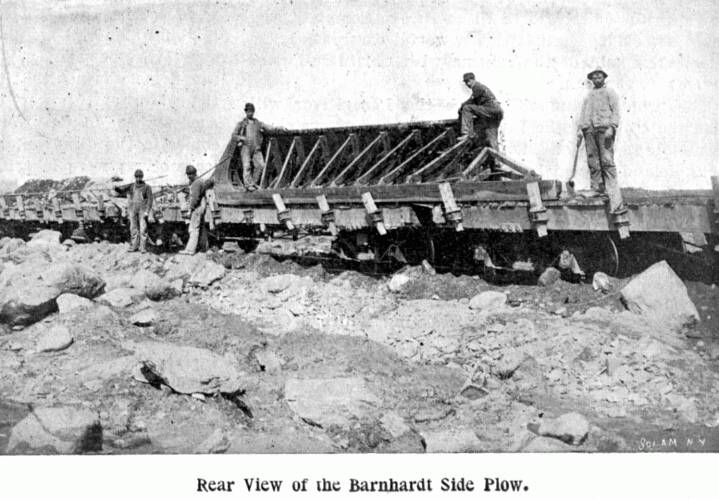
Another labor-saving device for the rapid unloading of material,
which is also extensively used at Jerome Park Reservoir, is the
Goodwin Patent Dump Car, of which we present two views. In cross-section
the car is of hopper form. The sloping sides of the car are hinged
so as to open outwardly, the hinges being locked by suitable catches.
When the dumping-place is reached the catches are released, and
the whole contents of the car are immediately discharged, as shown
in our snapshot view taken at the instant of unloading.
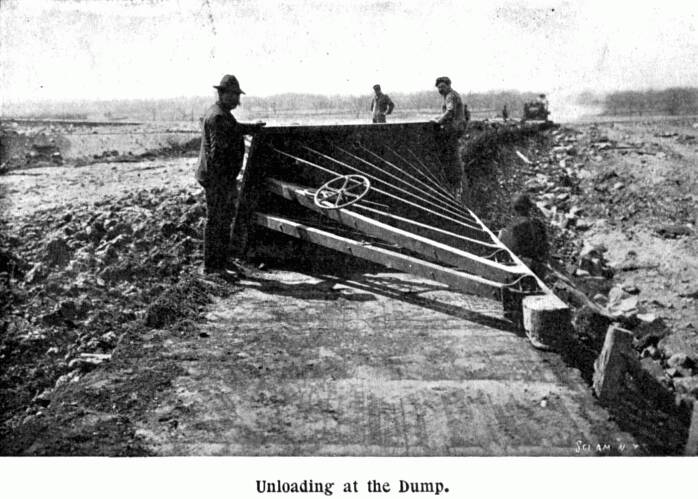
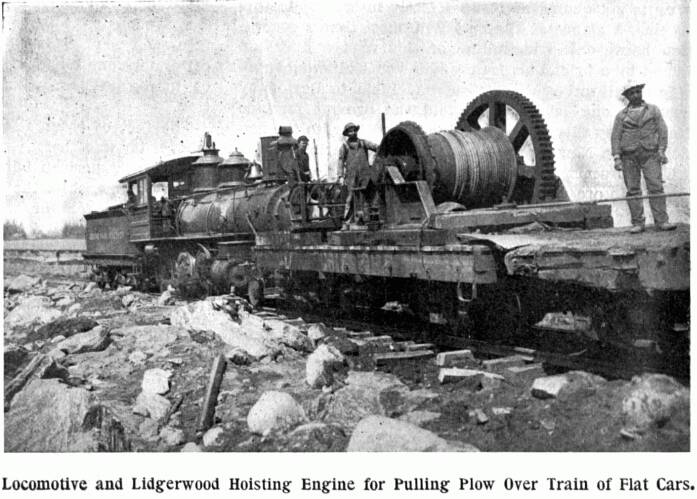
Stories Page | Contents Page
|







